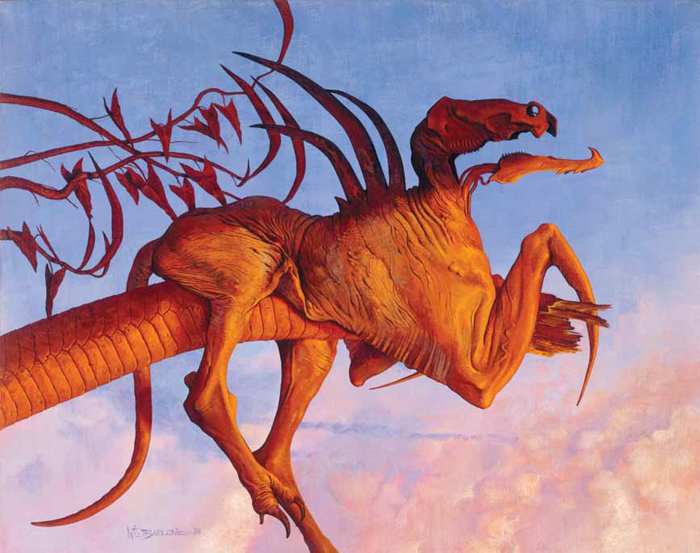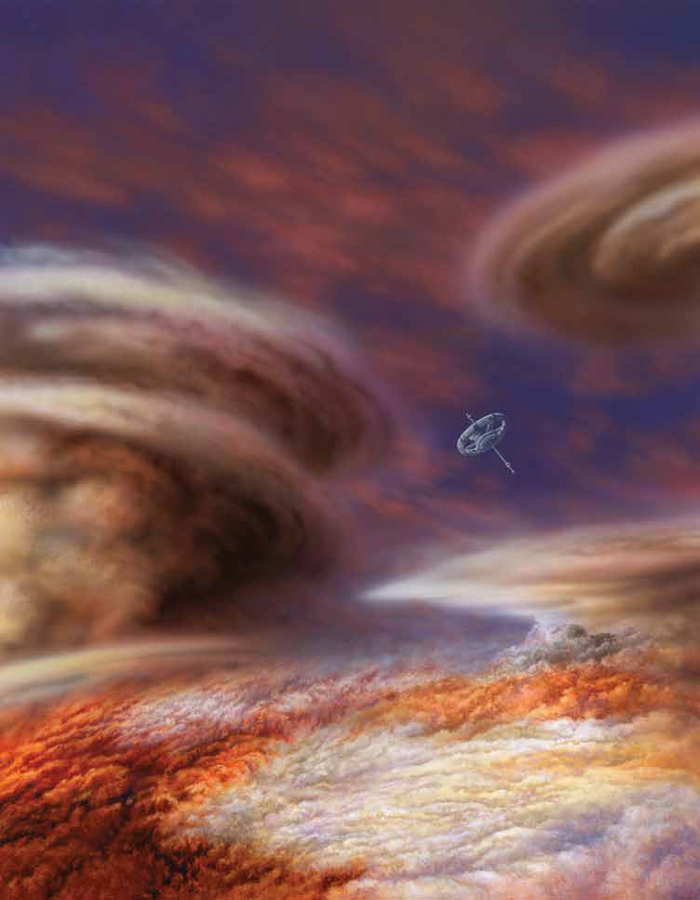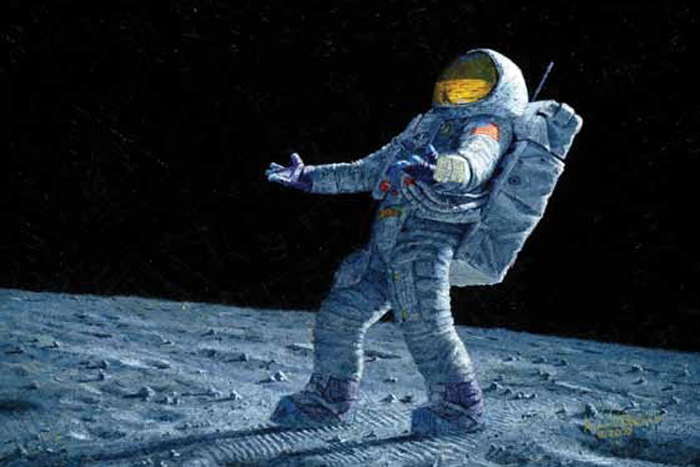
The Art of Space, Envisioning the Universe (Op-Ed)

Ron Miller is an award-winning artist and best-selling author who has written more than 50 books, including the recently published "The Art of Space: The History of Space Art, from the Earliest Visions to the Graphics of the Modern Era." (Zenith Press, 2014). His artwork has been featured in Scientific American, Astronomy, Science et Vie and other publications and has appeared in collections at the Smithsonian Institution and the Pushkin Museum. He has also contributed to Hollywood projects by David Lynch, James Cameron and others. Miller contributed this essay to Space.com's Expert Voices: Op-Ed & Insights.
There are many parallels between artists who devote themselves to recreating the distant ages of the Earth's past and those who recreate distant worlds in space. Both depend on science; both re-create — from many sources and forms — objects, creatures and places not otherwise visible to the human eye; and both allow scientists and others to see what otherwise could not be seen.
Because astronomers have, by and large, treated artists in many respects as colleagues, astronomical art has, in the 400-odd years of its existence, appeared in virtually every media, school and style. While many artists work closely with astronomers in creating scientifically accurate depictions of astronomical subjects, space artists have always felt free to interpret the wonders of astronomy and space exploration as they see fit. And even an artist trying to create a meticulously accurate scene set on, say, Titan will try to make his or her work successful as a landscape painting as well as a useful scientific document. As a result, astronomical art has run the gamut from the photorealistic to the absolutely abstract. And both astronomical art and astronomy have been the richer for it. [Inspiring Space Art Gallery: Space Foundation's Student Contest Winners 2013 ]
Artwork associated with other sciences does not seem to touch the soul to quite the depths space art does. Medical illustration looks inward to the microcosm, paleontological art into the distant past. But astronomy and astronautics look outward and have no bounds … and the art these sciences inspires does the same.

The evolution of astronomical art
Astronomical art is almost as old as modern astronomy — if one dates the latter back to the invention of the astronomical telescope. After the discovery of planets other than Earth, people wanted to know what these worlds looked like. Donato Creti was one of the earliest artists to satisfy this curiosity, creating a series of paintings in the 17th century that included images of the planets as seen with a Galilean telescope. And A. de Neuville's illustrations for Jules Verne's "From the Earth to the Moon" in 1865 were the first to attempt to depict spaceflight and scenes of other worlds with an inclination toward accuracy. [Alien Life, Landscapes and the Art of Space (Gallery)]
The latter part of the 19th century saw the publication of much space art: the artwork that accompanied Verne's "Off on a Comet," John Jacob Astor's "A Journey in Other Worlds," the models that illustrated James Carpenter and James Hall Nasmyth's "The Moon," work by Paul Hardy, Abbe Moreux, Stanley L. Wood, Fred T. Jane and others all helped to interpret the theories and discoveries of the era.
Get the Space.com Newsletter
Breaking space news, the latest updates on rocket launches, skywatching events and more!
The first great specialist in space art in the last century was Scriven Bolton, who combined detailed models with painting. He was closely followed by Lucien Rudaux, who can be said to have founded the art of space painting. Working primarily from the late 1920s to the late 1940s, his images of the planets, and especially of the moon and Mars, are so uncannily accurate that they could have been rendered in the last decade. He was a major influence on the grand master of astronomical art, the late Chesley Bonestell, from whom all modern space artists descend.
Art as inspired reality
Astronomy and astronautics owe much to the faithfulness and artistry of space painters, the same way that they owe a debt to science fiction. Artists showed the public the universe in images more real than the most gifted author could ever create. They showed that the Earth's sister planets were not merely an astronomer's speculation— these worlds instead possessed a reality no blurry telescopic photograph could ever convey.
In the mid-1950s, Wernher von Braun wrote a series of articles for the Collier's magazine space symposium series. And, as brilliant and exciting these articles were, what is most memorable are the evocative images created by Chesley Bonestell, Fred Freeman and Rolf Klep. Their work had a realism that was far beyond mere technical virtuosity, and there was a casual matter-of-factness about the pieces that made it seem as if they were painted from life. For the first time, spaceflight and the exploration of the universe seemed not a matter for the distant future, but for tomorrow.
Bonestell's paintings for Life magazine in the late 1940s, and later, for the now-classic books, "The Conquest of Space," "The World We Live In" and others, changed the public's perception, which had been molded by photographic images of planets that looked like pea-sized balls of cotton. Bonestell's renderings depicted what it would be like to actually stand on one of these worlds and see landscapes as real and strange as anything on Earth. "The Conquest of Space" looks more like a collection of postcards than the product of an artist's imagination. [Cosmic Creativity: A NASA Resident Artist's View of Space ]
Bonestell, while not the first to specialize in astronomical art, was the first to break the mental barrier of artist's "impression" that had existed between viewer and image. So compelling were Bonestell's landscapes of the moon that there was an almost universal sigh of disappointment after the first lunar landing when the moon revealed the lunar surface did not look like a Bonestell painting. This happened even though it had been fairly well-known since the 1920s that lunar mountains were not of an alpine cragginess, as Bonestell had portrayed them.
Astronomical painting is the modern descendant of landscape art from the Hudson River School; in fact, astronomical art is the last bastion of the Romantic approach to painting the universe. Its practitioners carry on this tradition, which was founded by masters like Albert Bierstadt and Thomas Moran. In the latter half of the 19th century, Bierstadt, Moran, Frederick Church and their colleagues were responsible for showing the public the wonders of the American continent. It was through the giant canvases of Moran and Bierstadt that Yellowstone and Yosemite were first seen in the East, eventually convincing the U.S. Congress to preserve these sites as the United States' first national parks.

Accuracy, and passion, in art
Astronomical artists serve the same function today, if any artwork needs a function beyond its existence. Because astronomical art depends so heavily on science to accurately depict its subjects, space painting is often assumed to have a strictly educational role, much like that imposed on early science fiction, most notably by editor Hugo Gernsback, who retained a battery of science experts to approve the accuracy of his stories. While astronomical art should be reasonably accurate, in the same way that a portrait should bear some resemblance to the sitter, there is no requirement that accuracy be the only raison d'être of a painting.
The balance between accuracy for its own sake and a purely imaginative interpretation is not easy to maintain. Kara Szathmary, for example, creates sublime, wholly abstract compositions inspired by astronomical and astronautical subjects. Artwork like his evokes emotions that a purely representative image cannot. ['The Art of Space' (US 2014): Book Excerpt]
Unfortunately, with only three exceptions, no astronomical artist has ever been able to visit the places he or she paints, and no space artist has ever worked from life. The exceptions are Apollo astronaut Alan Bean, whose lunar surface paintings benefit from his first-hand experience, and Vladimir Dzhanibekov and Alexei Leonov, the cosmonaut-artists and long-time collaborators with the late Soviet space painter Andre Sokolov. As long as every other space artist must depend on scientists and astronauts to provide the details of their subjects, astronomical painting will probably have to bear the burden of being thought of as mere illustration, an appendage to science and technology instead of a parallel development.
From landscapes to hardware to extraterrestrials
Space art can be divided into at least two broadly distinct sub-genres: astronomical painting and hardware art. The former is an extension of landscape painting and continues as an art form that has existed for centuries. Astronomical art has roots in the Pre-Raphaelites ,a school of art that demanded precise observation and depiction of nature, and their scrupulous attention to reproducing nature. It follows many of the same precepts as any successful landscape art. Its outstanding practitioners today include Don Davis, Michael Carroll, David Hardy and William Hartmann.

Hardware art concerns itself with the technology used to explore space, and its practitioners are more interested in how humans are going to get somewhere than in what they are going to find when they get there. Hardware artists have a much more difficult time divorcing themselves from the onus of technical illustration, because their work concerns itself so much with the accurate rendering of technology. Their art has the additional problem of quickly looking dated. Coping with these difficulties very nicely are such well-known artists as Pierre Mion, Pat Rawlings and the late Bob McCall.
There is, of course, a grey area between the two types of art. Nothing prevents an astronomical artist from including spacecraft in a painting or a hardware artist from placing a spacecraft in an interesting location. And there are artists who handle both types of art with equal skill. Those artists who are fortunate enough to be able to combine the two include Pamela Lee, Don Davis, Don Dixon and Rick Sternbach.
Perhaps the smallest division, —and the most difficult to categorize, consists of the few artists who specialize in creating extraterrestrial life forms — not necessarily wholly imaginary creatures, but aliens as well-thought-out as any paleontological recreation. While most space artists have worked in an extraterrestrial now and then, those who specialize in these figures make a very short list, which includes Joel Hagen and Wayne Barlowe.
At either end of the spectrum are artists who use space and space travel as a jumping-off points, allowing the public to see the symbolic, surrealistic and abstract, but always in terms invoking human emotion. They are space artists, too, and their work ranges from the serene mobiles of B.E. Johnson and Joy Alyssa Day to the surrealism of Lynette Cook. Space artists find expression in every medium, too, from traditional oils and acrylics to wood sculpture, glass and even quilting.
Space art seems to be gradually coming into its own, recognized not only by the art community as a legitimate genre in its own right, but, more importantly to the space artist, by scientists as well. Museums, planetariums and other institutions hold major exhibitions of space art every year.
Space art is also an international affair. The membership of the International Association of Astronomical Artists (IAAA) includes artists from around the world. Space art is taking a small, but not insignificant, step toward the realization that all people are passengers on the same space ship. Through trial and tribulation, space artists are creating dreams, inspiring dreamers and expanding the view of the universe.
Follow all of the Expert Voices issues and debates — and become part of the discussion — on Facebook, Twitter and Google+. The views expressed are those of the author and do not necessarily reflect the views of the publisher. This version of the article was originally published on Space.com.
Join our Space Forums to keep talking space on the latest missions, night sky and more! And if you have a news tip, correction or comment, let us know at: community@space.com.









